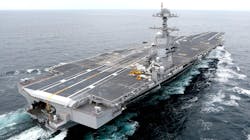Navy studies viability and survivability of large aircraft carriers as price and complexity take their toll
WASHINGTON – One of the hottest debates in the world of defense procurement and strategy surrounds the role that aircraft carriers will play in the future, one in which their ability to operate within striking distance of enemy shores is increasingly questioned. The Drive reports. Continue reading original article
The Military & Aerospace Electronics take:
19 March 2020 -- This issue has many facets, including air wing composition, the physical size of the carriers themselves, their propulsion type, shipbuilding capacity, force size, and more.
Price is also a huge factor. With the troubled Ford class supercarrier topping out at around $15 billion for a single hull, competing priorities like the massively expensive Columbia Class nuclear ballistic missile submarine and the Navy's dream of substantially expanding its surface combatant fleet are putting the viability of America's current supercarrier concept of tactical naval aviation power projection ever more in question.
The Future Carrier 2030 Task Force will soon be introduced and will partake in a six-month-long study looking at the viability and survivability of aircraft carriers in reflection of emerging threats that put into question carriers' their ability to project relevant combat capability forward during a peer-state conflict.
Related: The emerging world of hypersonic weapons technology
Related: Strike or surveillance: GAO says Navy needs to settle on role of future combat drone
John Keller, chief editor
Military & Aerospace Electronics
